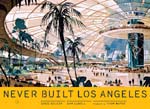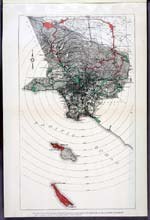
|

|
|
Home Site Search Contact Us Subscribe
|
|
|
Book Review: "Never Built Los Angeles" by Sam Lubell and Greg Goldin; foreword by Thom Mayne The contradictions and challenges of Los Angeles as a metropolitan conceit of perpetual promise continue. By Sam Hall Kaplan September 20, 2013 Editor’s note: The accompanying exhibition, “Never Built: Los Angeles,” co-curated by Sam Lubell and Greg Goldin and designed by Clive Wilkinson Architects, is on view at the A+D Architecture and Design Museum Los Angeles, July 28 – October 13, 2013.
Whether it is the city’s benign weather, casual character, or the aura of an unfettered society on the move and make, Los Angeles for the last century has attracted a cavalcade of self-styled and inspired creative personas. The manifest obvious is, of course, the enthroned entertainment industry with its glimmer of fame and fortune dangling before the panting public in this age of celebritydom.
Then, on a slightly loftier plain in this city of dreams, is architecture, as pursued by a multitude of professionals who over the years have set up practice here in search of select patrons and patronage for their immodest talent. Be it the excess of architecture schools in Southern California, or the publicity their self anointed celebrities generate, the design community of Los Angeles has had a transparent allure in good times and bad.
So one might ask: Why does the Los Angeles cityscape so disappoint, especially given its steady if sporadic growth, and its engaging if sprawling setting, presenting a potential for a most livable metropolis? Added to this mix is the constant, if not conflicted, encouragement of an ever-avaricious development community, preening politicians, and sycophantic bureaucrats. And let us not forget the good intentions and occasionally good ideas from good government groups and encrusted academic enclaves.
Putting this conundrum in illuminating perspective is the recently published Never Built Los Angeles (Metropolis Books, 2013). With a wealth of illustrations and an engaging if thin text, journalists Sam Lubell and Greg Goldin explore a revealing underside of the city’s fractured history that, while seemingly conducive to inventive design, actually spurns it.
Selectively surveyed are a wide variety of diverse public and private projects that never made it beyond the drawing boards. Exercises in "hope, hubris, naïveté,” and “hopeful, earnest, often arrogant, filling a staggering library of reverie and nerve,” declare the authors in lilting phrases that echo the moldering proposals.
The most fervent lament is for the city’s paltry public architecture. “Los Angeles lacks the grand gesture of urban innovations,” state the authors in their biting introduction. They note that while several of the best houses of the 20th century have been built in the city, “the same cannot be said of civic buildings or parks or plazas or monuments.” They add in characteristic immodesty that this, sadly, has prompted “the loss or displacement” of its own intellectual creative capital, namely its architects.
The few exceptions, such as Disney Hall and Griffith Park, are described as “almost accidental urban triumphs ... so singular that they underscore how little has been done, and how little they alone can do, to piece the city together into a compelling whole. “ Among the noted potentially transformative designs never making it off the drawing boards are a stunning master plan to green the city by the Olmsted Brothers and Bartholomew & Associates, a bold, muscular, modern civic center by Lloyd Wright, a futuristic international airport by Pereira & Luckman, and a mixed-use residential and cultural complex for downtown L.A. fashioned by a panoply of notable architects.
The latter is my favorite because I bore frustrated witness to its impressive unveiling and eventual ignoble rejection, rumored to be because of the failure of a developer to gift an apartment to a paramour of a local politician. It was this and other hints of malfeasance that, unfortunately, were not pursued by a naïve media wary of the machinations of design and development.
According to a more politically astute if circumspect Lubell and Goldin, most of the other inspired schemes failed because of a gap “between Los Angeles ‘s genius for design and its public output,” specifically aggravated by the city’s institutions, citizens, politics, sprawl, and infrastructure.
More pointed is architect Thom Mayne, who declares in the book’s foreword that “people love to portray the freedom of L.A.’s pluralism as a strength; in reality, it goes hand in hand with the city’s distinct failure to collectively embrace communal projects,” and why local architects have played such a minor role in shaping the public environment.
Some 100 projects are reviewed, most inspired, a few not that no doubt would have resulted in a more engaging, distinctive city, worthy of its climate and culture.
As a student of L.A. histrionics and history, the book makes one wonder about what might have been – and weep.
Then there is the adage that people get the city they deserve, and the riff on that: they get the city they actually want. From my view, there is no denying that there are many, some would argue a majority, who don’t want a city of iconic design, fashioned principally after Continental centric paradigms, by elitist architects. Rather they are content in Southern California’s sprawl, if only the freeways were more free and open.
Sam Hall Kaplan is a Los Angeles based urban planner and designer who has pursued a parallel career as a best-selling author (LA Lost & Found: An Architectural History of Los Angeles), an Emmy Award-winning commentator, and a caustic architecture critic, for the LA Times, among others. He is at present a contributor to The Planning Report, The Architect’s Newspaper and others, while in the real world he perseveres as an independent consultant aiding ailing cities and distressed development corporations. He can be reached at hallkaplan@earthlink.net.
Also by Hall Kaplan:
Book Review: Tripping Out to London and Paris
|
(click on pictures to enlarge)  Courtesy LAWA Flight Path Learning Center Cover image: Pereira and Luckman, LAX original Plan, 1952  Courtesy Eric Lloyd Wright Lloyd Wright Civic Center Plan, 1925  Huntington Library Olmsted and Bartholomew, Parks Playgrounds and Beaches for the Los Angeles Region |
© 2013 ArchNewsNow.com